The Weber’s Sailfin Lizard has a remarkable 9 cm (3.6 in) sail on its back. This semi-aquatic lizard lives in the tropical forests of Southeast Asia. It’s known for its size, reaching up to 3 feet long.
These lizards have adapted to live both in trees and in water. Their unique lifestyle makes them very interesting to learn about.
The Weber’s Sailfin Lizard is part of the Hydrosaurus genus. It shares this group with other species like Hydrosaurus pustulatus and H. Amboinensis. Named after Professor Max Weber, a Dutch zoologist, these lizards have gained a lot of attention.
Introducing the Weber’s Sailfin Lizard
Classification and Appearance
The Weber’s Sailfin Lizard belongs to the Hydrosaurus genus and the Agamidae family. It’s a semi-aquatic lizard, closely related to iguanas. Found in the Moluccas of Southeast Asia, it can reach up to 3.5 feet long. This makes it the biggest in the Agamidae family.
Male Weber’s Sailfin Lizards have big tail crests and sail-like fins. Females have smaller fins. Both have big nasal knobs and special pores on their bodies. They can be green or brown, helping them hide in the forest.
Distribution and Habitat
These lizards live on islands in the Indonesian Moluccas, like Halmahera, Ternate, and Morotai. They love the forest environments near rivers and streams. Here, they use their skills to move on land and in water.
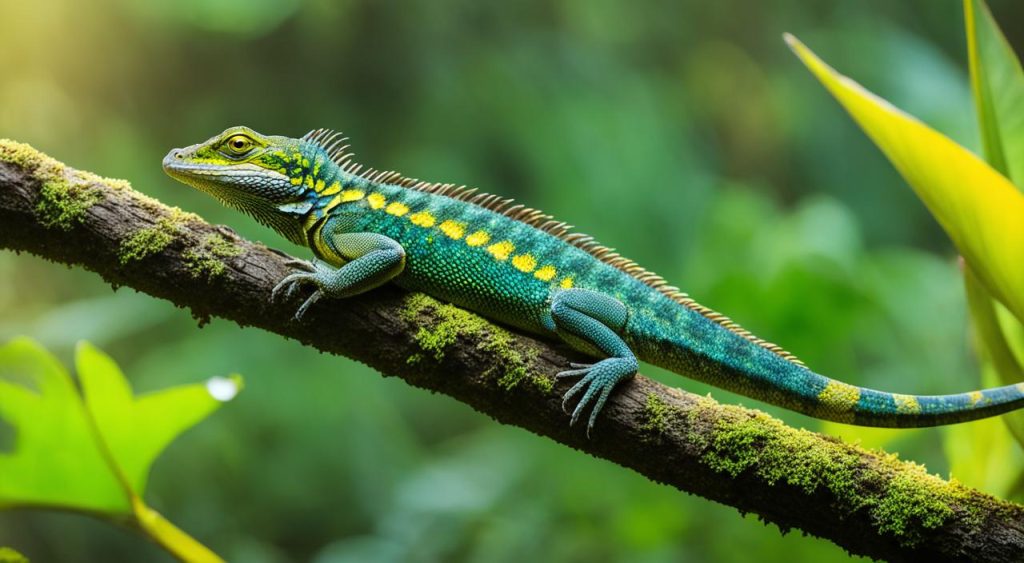
“The Weber’s Sailfin Lizard is a true marvel of nature, blending graceful aquatic abilities with impressive terrestrial agility.”
The Weber’s Sailfin Lizard is a favorite among reptile lovers and conservationists. Its unique look and special place in nature make it very interesting.
Adaptations for Semi-Aquatic Living
The Weber’s Sailfin Lizard, known as Hydrosaurus weberi, has amazing adaptations for living in water and on land. These features help it live well in both places, showing its great flexibility.
One key feature is its long, slightly flattened tail. Along with its large, webbed feet with extra skin, it helps the lizard swim and move in water. It can stay underwater for more than 15 minutes, showing its amazing water skills.
The lizard is also great at living in trees. It can climb and move fast through the branches. This mix of living in water and trees makes the Weber’s Sailfin Lizard unique and well-suited for different places.
| Adaptation | Description |
|---|---|
| Flattened Tail | Aids in swimming and maneuvering through water |
| Webbed Feet with Skin Flaps | Enhances swimming and aquatic mobility |
| Prolonged Underwater Breathing | Can remain submerged for over 15 minutes |
| Arboreal Capabilities | Able to climb and move through trees with ease |
These amazing features, along with its size and build, make the Weber’s Sailfin Lizard a fascinating reptile.
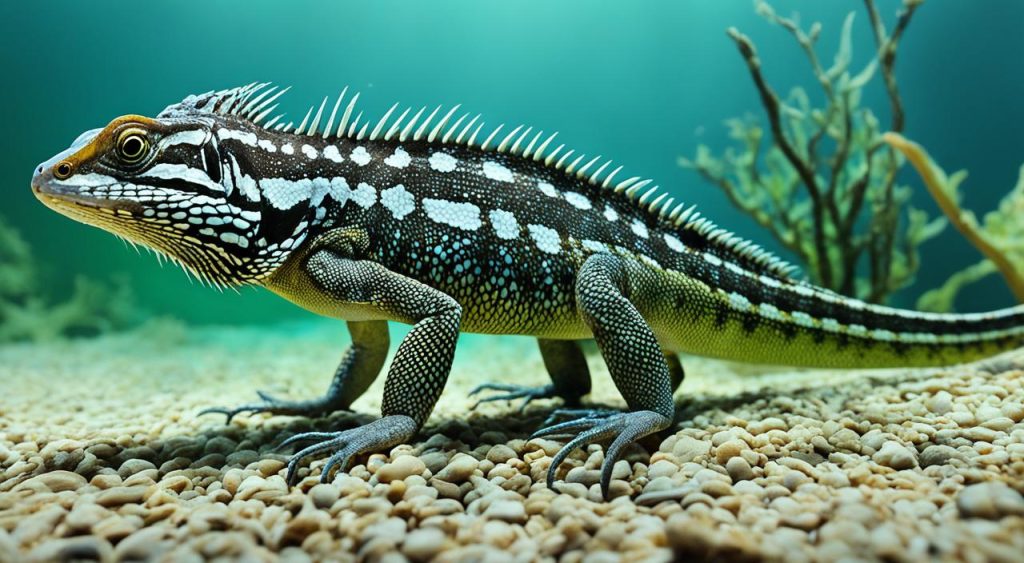
“The Weber’s Sailfin Lizard is a prime example of how evolution can produce remarkable adaptations, allowing a species to thrive in a diverse range of environments.”
Behavior and Diet
Weber’s Sailfin Lizards are amazing creatures with interesting behaviors and ways that help them live in the trees. They spend most of their time climbing and moving through the trees. This lets them use their climbing and swimming abilities to the fullest.
Arboreal Lifestyle
Being part of the agamid lizard family, Weber’s Sailfin Lizards are perfect for living in the trees. They have strong arms and sharp claws that let them move easily through the branches. They can also swim well, jumping into the water to get away from predators or to cool down.
Feeding Habits
Weber’s Sailfin Lizards eat both plants and animals, making them omnivorous. They eat fruits, veggies, bugs, frogs, and other small animals they find in their feeding habits. They use their sharp teeth and strong jaws to eat their omnivorous diet.
When they feel threatened, these lizards can run fast on the water’s surface, especially in young ones. Their climbing and swimming abilities help them quickly get away from danger and move through their arboreal habitat.
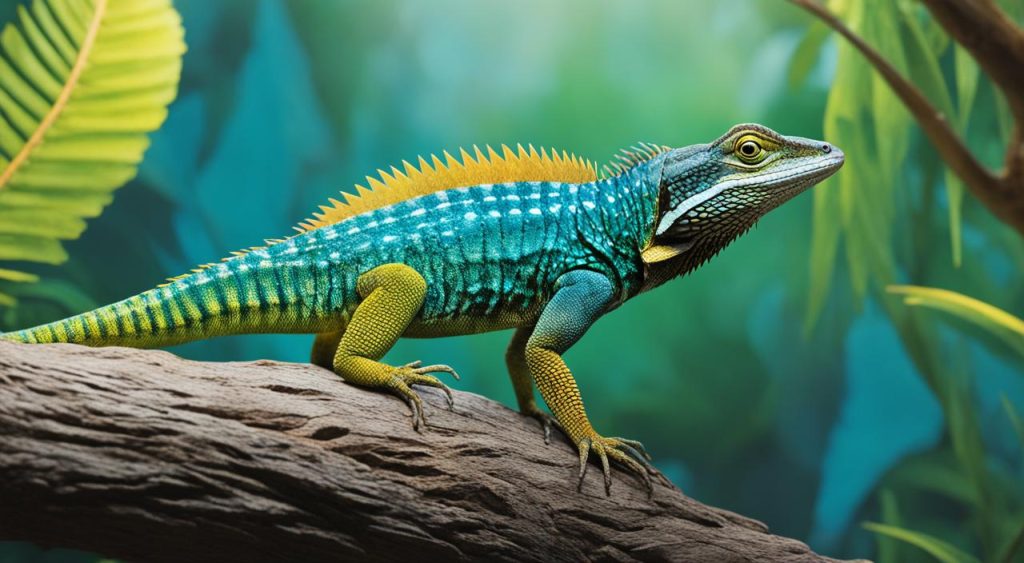
Weber’s Sailfin Lizard in Captivity
Keeping Weber’s sailfin lizard (Hydrosaurus weberi) in captivity is not easy. It takes a lot of time, effort, and special knowledge. These lizards are not as common as some other reptiles, but some people keep them.
Care and Housing Requirements
Weber’s sailfin lizards live in water and on land. They need a big, special home that has space for swimming, climbing, and basking. The home should have a deep water pool, plants, and places to climb.
The temperature in their home must be just right. There should be a warm spot for basking and a cooler area for resting. They also need special lights to stay healthy.
These lizards eat both plants and animals. They need a diet with greens, fruits, insects, small fish, and sometimes rodents. They also need extra calcium and vitamins to stay healthy. They can live up to 25 years in captivity.
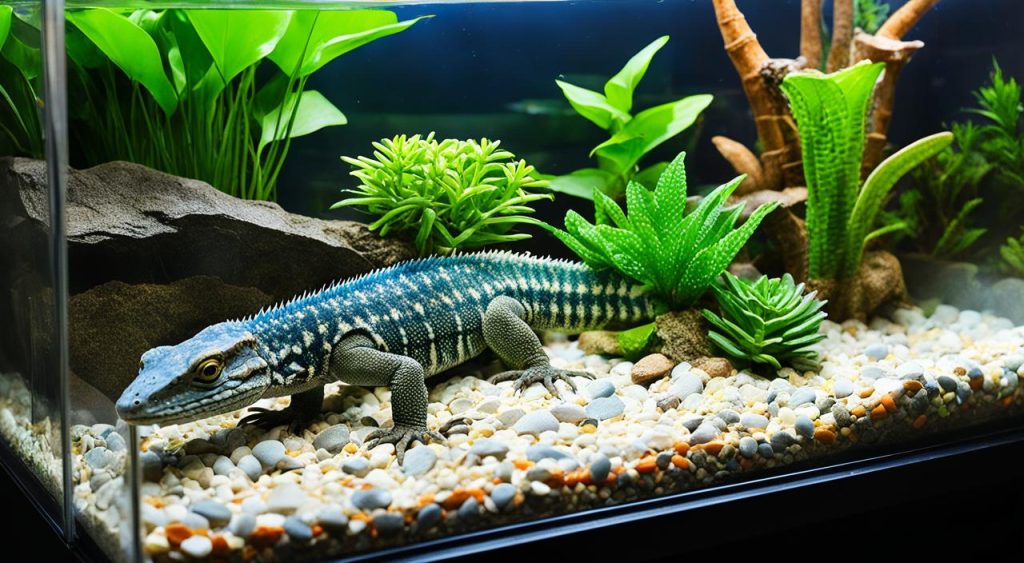
Looking after Weber’s sailfin lizard is a big job. It needs a lot of time, resources, and special knowledge. Anyone thinking of getting one must be ready to give it a big, well-kept home. This way, the lizard can be happy and healthy.
Conservation Status and Threats
The Weber’s Sailfin Lizard, known as Hydrosaurus weberi, is listed as Vulnerable on the IUCN Red List. This unique reptile lives only in the Halmahera and Ternate Islands of Indonesia’s Maluku region. Its survival is threatened by several environmental factors.
Habitat loss and degradation are big concerns for the Weber’s Sailfin Lizard. These lizards need their tropical forests to survive. But, these forests are being destroyed by coastal development and deforestation. In the Philippines, over 75% of mangrove forests have been lost in 75 years, mainly for urban growth and aquaculture.
Another threat is poaching and illegal trade. These lizards are hunted for the exotic pet trade. Since 2010, they have been traded in North America, Asia, and Europe. They can sell for about $700 each, making them a big target for traffickers.
| Conservation Status | Threats |
|---|---|
| Vulnerable (IUCN 3.1) | Habitat loss and degradation Poaching and illegal trade |
Conservationists want to list the Philippine Sailfin Lizard in CITES Appendix III. This would help stop illegal trade and regulate the trade of captive-bred ones. They also suggest creating a database to track species and protect them better.
The “Sailfin” and Its Unique Display
The Weber’s Sailfin Lizard is known for its large “sailfin” that can grow up to 9 cm (3.6 in) tall in males. This sail-like structure is not bone-supported, unlike the Dimetrodon‘s frill. It’s thought to be used for display, possibly for mating and defending territory.
In males, the sailfin is much more visible than in females. This sexual dimorphism in the sailfin’s size and color shows its key role in mating and social dynamics of the Weber’s Sailfin Lizard.
The function of the sailfin in Hydrosaurus weberi goes beyond just showing off. It helps with temperature control and swimming balance. The sail acts as a thermostat and a balance aid in the water.
The size and coloration of the male sailfin play big roles in mating rituals and territorial disputes. Bigger, brighter sails show dominance and health, drawing in mates and keeping rivals away.
| Characteristic | Male | Female |
|---|---|---|
| Sailfin Height | Up to 9 cm (3.6 in) | Less Prominent |
| Head Size | Larger | Smaller |
| Limb Coloration | Darker, Turning Violet During Mating | Lighter |
Reproduction and Life Cycle
Weber’s Sailfin Lizards, or Hydrosaurus weberi, lay eggs. They are oviparous reptiles. Females dig nests near water during the breeding season. They lay a few hard-shelled eggs there.
After two months, the eggs hatch. The hatchlings are ready to explore the world.
Breeding and Nesting
The breeding and nesting of Weber’s Sailfin Lizards are interesting. These lizards use their sailfins and other signs to find mates. After mating, the female picks a spot near water to lay her eggs.
She digs a shallow nest in the soil for this.
Hatchlings and Juvenile Development
After about two months, the eggs hatch. The hatchlings can run, swim, and climb right away. They grow up quickly, showing off their sailfins and other adult traits.
| Characteristic | Value |
|---|---|
| Average Lifespan | 20-25 years |
| Hatchling Size | Approximately 6 inches |
| Mature Size | 35-42 inches |
| Incubation Period | Around 2 months |
Weber’s Sailfin Lizards go through a remarkable life cycle. From laying eggs to growing their sailfins, they show how adaptable and resilient they are.
Fascinating Facts about Weber’s Sailfin Lizard
The Weber’s Sailfin Lizard, known as Hydrosaurus weberi, is a fascinating reptile. It can run on water, especially when young. This skill shows how well it has adapted to its semi-aquatic life.
These lizards stand out with their bright orange arm bands. They also have a unique look because their sailfins don’t have bones. This makes them different from other lizards with similar features.
Their prehistoric appearance hints at their ancient origins. Sailfin lizards, including the Weber’s Sailfin, date back to the Miocene epoch. They are like living fossils from millions of years ago.
| Characteristic | Value |
|---|---|
| Scientific Name | Hydrosaurus weberi |
| Weight | Up to 5 lbs |
| Length | Up to 4 feet, including tail |
| Lifespan | Up to 20 years |
| IUCN Listing | Vulnerable |
The Weber’s Sailfin Lizard is a true wonder of nature. It has amazing adaptations, a unique look, and a long history. It’s a creature that captures our imagination and deserves our respect.
Weber’s Sailfin Lizard: Prehistoric Beauty
The Weber’s Sailfin Lizard has a prehistoric look with its big size and sailfin. It also has semi-aquatic features like ancient reptiles. These lizards are similar to the extinct Dimetrodon, showing how they’ve adapted over time.
These lizards are 2 to 3 feet long, making them the smallest of their kind. Yet, their look is still amazing. They have long tails, extra skin on their toes, and bright orange arm bands. This helps them live in the water for over 15 minutes.
It’s important to protect the tropical forests where these reptiles live. They face threats from losing their homes and being taken from the wild. By saving their homes, we help these unique lizards and keep them inspiring us for years to come.
FAQ
What is the Weber’s Sailfin Lizard?
The Weber’s Sailfin Lizard is a unique reptile from Southeast Asia’s tropical forests. It’s semi-aquatic and known for its “sailfin” display. Adult males’ sailfins can grow up to 9 cm (3.6 in) tall.
What is the classification and appearance of the Weber’s Sailfin Lizard?
It belongs to the Hydrosaurus genus and the Agamidae family. These lizards are like iguanas and have a special “sailfin.” They can grow up to 3 feet long. They have a long tail, large webbed feet, and skin flaps for swimming.
Where are Weber’s Sailfin Lizards found?
They live on islands in Indonesia, like Halmahera, Ternate, and Morotai. They stay in tropical forests near rivers and water, using their semi-aquatic skills.
What adaptations do Weber’s Sailfin Lizards have for their semi-aquatic lifestyle?
They have a long tail and big, webbed feet with extra skin for swimming. They can stay underwater over 15 minutes, showing their aquatic skills.
How do Weber’s Sailfin Lizards behave and what do they eat?
They spend most of their time in trees, using their tree skills. They eat fruits, plants, insects, frogs, and small animals. When scared, they jump into the water and can stay there for a long time.
How are Weber’s Sailfin Lizards cared for in captivity?
Some people keep them as pets. They need a big tank with water and places to climb. Their diet includes greens, fruits, insects, fish, and rodents. With the right care, they can live up to 25 years.
What is the conservation status of the Weber’s Sailfin Lizard?
The IUCN Red List says it’s not threatened, but it could be due to habitat loss. Keeping their forests safe is key to protecting this unique reptile.
What is the function of the Weber’s Sailfin Lizard’s distinctive “sailfin” display?
The “sailfin” is a big feature on their back, up to 9 cm tall in males. It’s not bone but helps in showing off, likely for mating and defending territory.
How do Weber’s Sailfin Lizards reproduce and develop?
They lay eggs near water, which hatch in a few months. The babies are active and can swim and climb right away. As they grow, they show off their sailfins and become more like adults.
What makes the Weber’s Sailfin Lizard a fascinating and unique reptile species?
They look prehistoric with their size and sailfin. They remind us of ancient reptiles but have evolved to live in the forest. Their adaptations are a testament to their survival in their habitat.
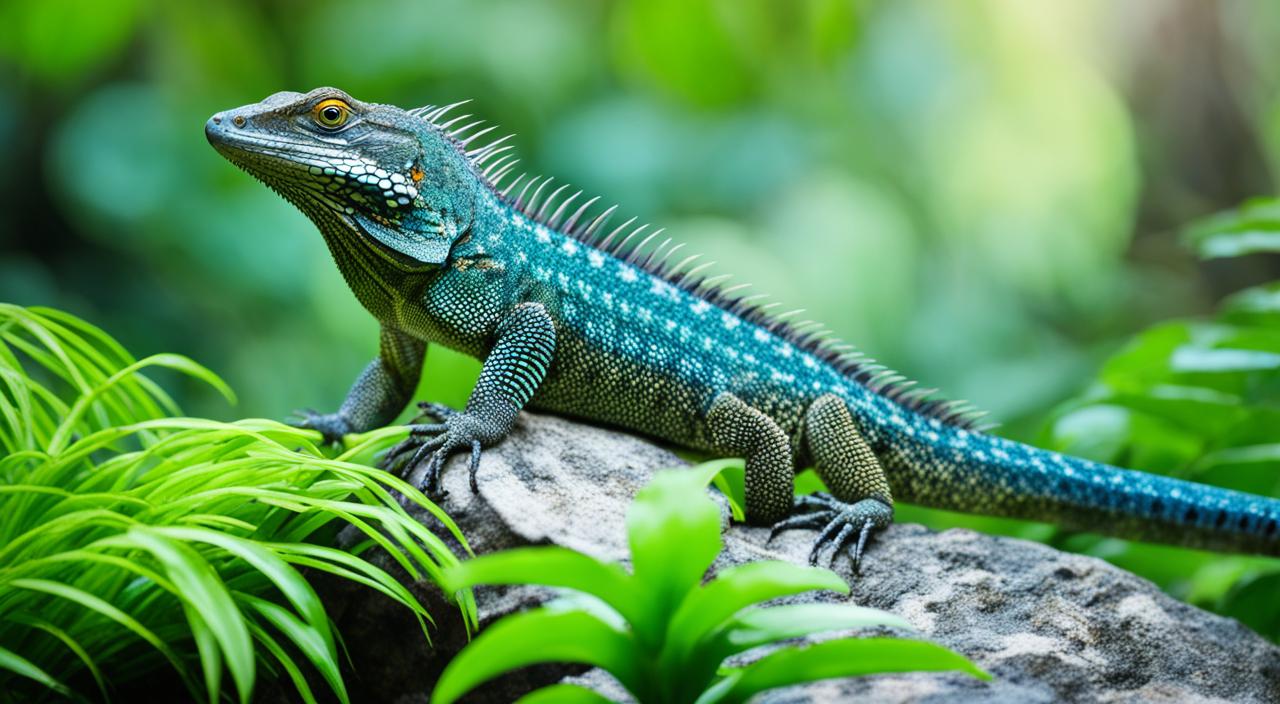
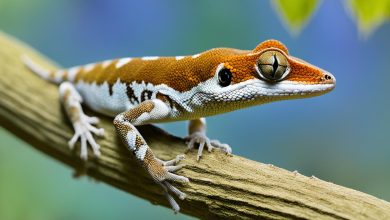
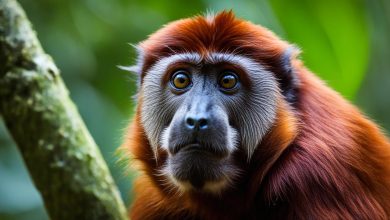


One Comment